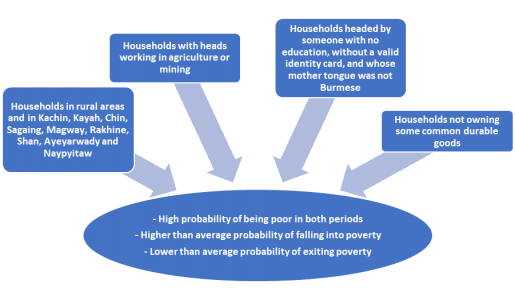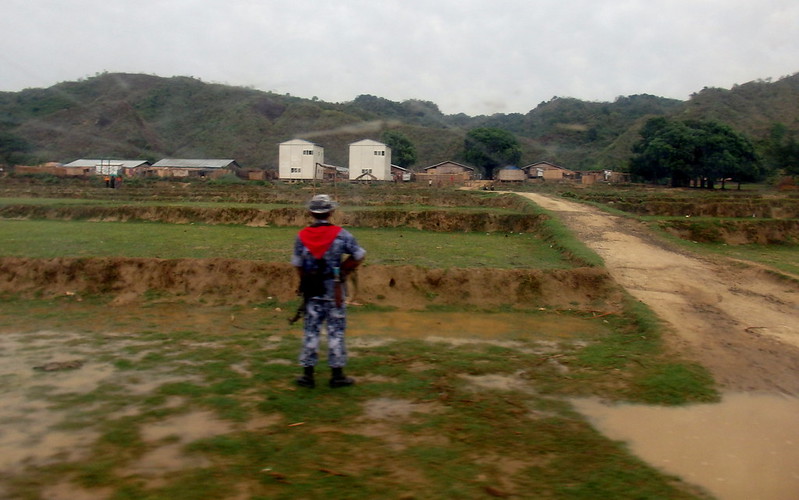Myanmar has suffered, along with the rest of the world, from the devastating impact of the Covid-19 pandemic. Additionally, it has had to contend with the instability and violence induced by the military coup of February 2021. By September of last year, the United Nations was warning of a human rights ‘catastrophe’ in the country, arising from a mix of widespread violence, food insecurity and rapidly rising poverty. Ines A. Ferreira, Vincenzo Salvucci and Finn Tarp share insights from their research in the country to identify the characteristics of households particularly vulnerable to falling into poverty – insights that can play a crucial role in the design and delivery of optimally-targeted humanitarian efforts.
Myanmar achieved distinct progress in economic growth and poverty-reduction during the years 2005-18. However, extreme natural events, economic, political and social crises, the ongoing Covid-19 shock and the February 2021 military coup have posed serious challenges to both growth and poverty reduction.
In our study “Poverty and vulnerability transitions in Myanmar: An analysis using synthetic panels”, we complement previous analyses of poverty and vulnerability in Myanmar, providing a dynamic perspective on development during the 2015–17 period. Given the lack of longitudinal household data (i.e., data on the same households over time), we relied on the synthetic panels approach to further our understanding of how households transition between different states of material well-being – poverty, vulnerability, and non-poverty – and the household characteristics associated with these transitions. We applied this methodology to the 2015 Myanmar Poverty and Living Conditions Survey (MPLCS) and the 2017 Myanmar Living Conditions Survey (MLCS).
The 2015–17 period was a ‘moderately high-growth’ period, and our results reflect that. The subsequent Covid-19 pandemic and the February 2021 coup have undoubtedly undone much of the prior progress and influenced the profiles of poverty and vulnerability transitions. We do not account explicitly for these two events in the following discussion due to lack of data, though we include some concluding considerations at the end of the post about their impact.
Background
Several key events occurred in 2015–17 that shaped Myanmar’s socioeconomic and political situation, and its relations with the rest of the world. In 2015, the National League for Democracy won the parliamentary elections, obtaining over 80% of the available seats. These elections ended more than five decades of military rule and signalled a new era of economic recovery, democratic transition, and much desired ethno-religious reconciliation. At the same time, 2015 was a precarious year in the long-standing Rohingya crisis, with approximately 94,000 refugees and migrants departing by sea from Bangladesh and Myanmar, according to a 2015 UNHCR report. This led many to criticise the government and its policies towards minorities. Nevertheless, economic growth mostly continued, even accounting for severe flooding in the second half of 2015. Subsequently, about 700,000 Rohingya fled in 2017 to neighbouring Bangladesh, further damaging Myanmar’s international image; yet, little noticed was the fact that poverty in the country had been on a downward trend (Figure 1). About half of the population was poor in 2005 (48.2%), but the poverty rate has been estimated to have declined to 42.4% in 2010, 32.1% in 2015, and close to a fourth in 2017 (24.8%).
Figure 1: Poverty rates and GDP growth rates, 2005–19

Data source: Authors’ elaboration based on the 2020 World Bank report ‘Myanmar Economic Monitor Dec 2020: Coping with COVID-19’, and on the ‘Key Indicators Report’, ‘Technical Report’ and ‘Poverty Report’ of the ‘Myanmar Living Conditions Survey 2017’, produced by the Central Statistics Office, UNDP and World Bank.
Notes: The poverty rate in 2017 does not consider data from the northern parts of Rakhine State (Maungdaw and Buthidaung townships) and the Wa Self-Administered Division, as it was not possible to survey households in these areas. See full documentation of limitations in coverage in the ‘Technical Report’ of the ‘Myanmar Living Conditions Survey 2017’, produced by the Central Statistics Office, UNDP and World Bank.
Our Research
However, the dynamics of poverty was unclear and we knew little about households’ transition in and out of poverty. We therefore proceeded to compute and assess the proportion of households that were poor (or vulnerable, or non-poor) in both 2015 and 2017, or that were either poor, vulnerable or non-poor in 2015 and changed their status in 2017.
At national level, we estimated that for people, who were poor in 2015, there was a respectable probability (about 40%) of exiting poverty in 2017. Moreover, for non-poor individuals in 2015 the risk of becoming poor in 2017 was only about 6%. We furthermore established that people in a vulnerable situation were relatively more likely to become non-vulnerable than to enter poverty (50% versus 15%). All of these indicators signalled progress, though the probability of remaining in a vulnerable situation was non-negligible at national level (about 35%).
Moreover, we identified a set of distinct household characteristics associated with three correlations in the data. First, the relatively high probability of being poor in both periods. Second, a higher than average probability of falling into poverty if the individual was non-poor at a level higher than the country average. Third, a lower than average probability of exiting poverty in 2017 if the individual was poor in 2015 at a level lower than the country average. In particular, these policy-relevant characteristics included households in rural areas; and households in the states/regions of Kachin, Kayah, Chin, Sagaing, Magway, Rakhine, Shan, Ayeyarwady and Naypyitaw. The same applied to households with heads working in agriculture or mining; households headed by someone with no education, without a valid identity card, whose mother tongue was not Burmese, and not owning some common durable goods (Figure 2).
Figure 2: Characteristics of particularly vulnerable households

The Covid-19 pandemic and the February 2021 military coup struck at a time when growth rates were high, but experiencing a contraction that has worsened since.
There is therefore no doubt that the poverty/vulnerability patterns outlined using 2015–17 data deteriorated during 2020–21.
The sudden halt in the democratisation process, international isolation, increased violence and warfare, reduced freedom of speech and movement – among other processes – are all factors that most certainly contributed to increasing the number of poor and vulnerable people, in addition to making household transition from non-poverty to a situation of poverty or vulnerability more likely. Consequently, the proportion of households in the vulnerable and poor group has clearly increased, including household categories previously regarded as less vulnerable.
At the same time, our conjecture is that our analysis of poverty dynamics during a period of general progress may well help understand who will be particularly badly hit by the indirect socioeconomic consequences of the recent shocks, alongside those suffering from outright oppression and violence. Our results show that high levels of persistence of poverty and low levels of upward mobility were concentrated in specific areas of the country and for well-determined household categories, which make the consequences of the pandemics and the coup even more worrying. Indeed, while ‘new’ vulnerable groups have emerged, households and individuals who were already poor or vulnerable in high-growth times will clearly be worse off after 2021, and the ‘standard’ or ‘long-term’ poverty and vulnerability drivers are unlikely to have changed substantially. The need to focus on the plight of the households with the specific characteristics outlined above, which make them more at risk of remaining poor or falling into poverty compared to the rest of the population, should be kept in mind as the troubled history of Myanmar unfolds.
Our study was prepared under the Data and Evidence to End Extreme Poverty (DEEP) project, funded with UK aid from the UK government and managed by Oxford Policy Management (OPM).
Banner Image: Photo by Ajay Karpur on Unsplash.
The views expressed here are those of the authors and not of the ‘South Asia @ LSE’ blog, the LSE South Asia Centre, or the London School of Economics and Political Science.







